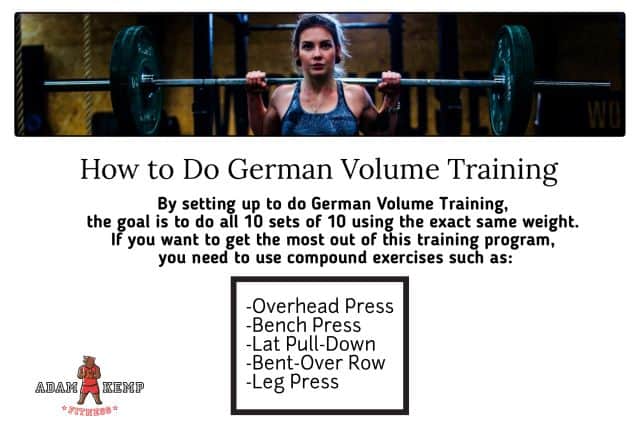German Volume Training Benefits & GVT Workout Routine Tips
Few training methods match the intensity of German Volume Training (GVT).
Also known as the “10 sets of 10 reps” method, GVT has become a go-to for weightlifters and bodybuilders seeking rapid muscle growth.
By focusing on high-volume compound exercises like bench presses or squats, German Volume Training pushes your body to adapt, promoting muscle hypertrophy like few other programs can.
Throughout my basketball career, I’ve turned to GVT during the offseason to build upper body mass, especially with the bench press.
While it may not be the best program for developing maximum strength, its ability to pack on muscle is unparalleled.
Whether you’re an athlete looking to condition your body or a fitness enthusiast aiming for size, GVT delivers results when used effectively.
Whether you’re a pro athlete like myself or a fitness newbie looking to build some extra muscle mass, this article explores the benefits of German Volume Training, its game-changing variations, and equips you with insider tips to make this powerhouse program a staple in your training arsenal.
What is German Volume Training?
German Volume Training (GVT) is a high-volume, intense weightlifting program designed to maximize muscle growth and strength development.
Popular among bodybuilders, powerlifters, and athletes, GVT has earned its reputation as one of the most effective hypertrophy-focused training methods.
While its roots trace back to Europe in the 1940s, the modern GVT program was refined in 1996 by renowned strength coach Charles Poliquin.
Often called the “10 sets of 10 method,” this approach involves performing 10 sets of 10 repetitions for a specific compound exercise, totaling 100 challenging reps per lift.
The core philosophy of GVT is simple yet powerful: overload the muscles with high volume to stimulate growth.
The program is centered around compound movements like squats, bench presses, and deadlifts, which recruit multiple muscle groups and create the systemic stress needed for hypertrophy.
Although countless adaptations of GVT exist to suit individual goals, the original structure remains a cornerstone for those seeking proven results.
The classic GVT workout includes one or two main compound lifts performed for 10 sets of 10, supplemented by accessory exercises with lower volume to avoid overtraining.
This method emphasizes controlled tempo and strict form, ensuring optimal muscle engagement and minimizing the risk of injury.
By incorporating both foundational movements and targeted accessory work, GVT strikes a balance between intensity and precision, making it a favorite for athletes and fitness enthusiasts alike.
Benefits of German Volume Training
German Volume Training (GVT) is a versatile and time-effective workout regimen that offers numerous benefits for individuals pursuing various fitness goals.
Whether you’re looking to burn fat, build muscle, or enhance your athletic performance, GVT can be an invaluable addition to your training program.
A study published in the NSCA’s Performance Training Journal highlights the effectiveness of GVT, stating that
“this type of workout is time effective, may be very stimulating or challenging for advanced athletes, and apart from the expected muscle fatigue/super-compensatory growth considerations, there appears to be a moderate cardiovascular training effect.”
Here are some reasons to consider incorporating German Volume Training into your fitness routine:
Burns Fat and Builds Muscle
GVT’s high-volume approach, consisting of 10 sets of 10 reps at approximately 60% of your 1RM, is effective for both burning fat and building muscle.
In addition to promoting muscle growth, the increased volume of training and resulting boost in muscle mass can help shed stubborn body fat over time.
While cardiovascular exercise is one way to burn fat, building muscle offers an enjoyable and effective alternative to traditional fat-burning methods.
Especially for people interested in cutting fat without losing muscle, german volume training is an excellent option.
Improves Aerobic Work Capacity
The large number of sets and reps per exercise increases your work capacity, making GVT particularly well-suited for athletes and bodybuilders alike.
The intense nature of GVT can help enhance your aerobic work capacity, which is vital for various athletic competitions.
The cardiovascular benefits gained from GVT can complement traditional endurance training, providing a well-rounded approach to fitness.
Challenges Your Body
GVT is a demanding training regimen that pushes your body to its limits, forcing it to adapt and improve continually.
This intense workout program has been proven to deliver results for decades, helping world-class athletes and bodybuilders achieve remarkable performance gains.
Improved Overall Health
A research study that investigated the acute effects of German Volume Training on health outcomes found that this resistance training method led to significant decreases in systolic blood pressure, diastolic blood pressure, and mean arterial pressure while increasing heart rate, rate pressure product, and rating of perceived exertion.
These findings suggest that GVT may promote post-exercise hypotension and has an appropriate intensity level to increase objective heart rate and subjective exertion intensities.
Therefore, GVT can be considered suitable for various health promotion settings, particularly for those looking to incorporate resistance training into their exercise routines.
How to Do German Volume Training

German Volume Training (GVT) is designed to push your muscles to the limit, promoting muscle hypertrophy and strength gains through high-volume, compound exercises.
To get the most out of GVT, it’s essential to use the right exercises, adhere to strict rest intervals, and progressively increase the weight.
Here’s how to set up and execute a GVT workout:
Choose Compound Exercises
The key to GVT’s effectiveness lies in using compound exercises that engage multiple muscle groups. Some excellent compound exercises to include in your GVT program are:
- Overhead Press
- Bench Press
- Lat Pull-Down
- Bent-Over Row
- Leg Press
I especially love doing German Volume Training for the bench press. I believe it is one of the best bench press programs, and it has given excellent results over the years when I was trying to build more muscle mass in my upper body.
Avoid exercises where your form can break down quickly, as proper technique is crucial to prevent injuries and maximize gains.
Determine the Appropriate Weight
Start by selecting a weight that you can lift for approximately 20 reps.
This weight should be challenging but manageable for completing the 10 sets of 10 reps.
Alternatively, some bodybuilders use 60% of their one-rep max as a starting point.
Maintain Strict Rest Intervals
Rest intervals play a significant role in GVT’s success.
Keep your rest time between sets to 60-90 seconds, with 60 seconds being the optimal duration.
Maintaining these strict rest intervals helps ensure your muscles are consistently challenged throughout the workout.
Progressive Overload
If you can successfully complete all 10 sets of 10 reps, return to the gym in 3-4 days and increase the weight by 5 lbs.
If you cannot complete all 100 reps, continue with the same weight in your next session and check for improvement.
Gradually increasing the weight ensures that your muscles are continually adapting and growing.
Comparing Different Versions of GVT
A study compared two modified German Volume Training (GVT) programs to see how they affected muscle growth and strength.
One group did 10 sets of 10 repetitions, while the other did 5 sets of 10 repetitions.
Both groups saw improvements in muscle size, but the group that did 5 sets had better results for their upper body in specific exercises like the bench press and lat pull-down.
The study concluded that doing 10 sets of each exercise in GVT is not more effective than doing 5 sets for increasing muscle size and strength.
Researchers recommended doing 4-6 sets per exercise to get the best results, as doing more sets may not lead to more gains and could even lead to overtraining and less progress.
Another study examined the effects of a 12-week modified GVT program on muscle strength and growth.
They found that doing more than 5 sets per exercise doesn’t lead to better muscle strength and growth results.
This suggests that doing around 5 sets per exercise could be the best approach for improving muscle strength and size with GVT.
Assistance Exercises for GVT
German Volume Training (GVT) is an effective method for building muscle and increasing strength.
While GVT primarily focuses on compound exercises, incorporating accessory exercises and yoga into your routine can enhance your results and improve overall fitness.
Why Assistance Exercises Are Crucial
- Increased Overall Performance: Stronger stabilizers and balanced muscles translate to improved performance in the main GVT lifts. For instance, Bulgarian split squats enhance single-leg strength and stability, which directly benefits squats and deadlifts.
- Correcting Imbalances: Compound lifts like squats and bench presses can sometimes lead to over-dominance of stronger muscles, leaving weaker ones underdeveloped. Assistance exercises help target these lagging areas, ensuring balanced muscle development and reducing the risk of overuse injuries.
- Rehabilitation and Injury Prevention: If you’re recovering from an injury or have a history of joint or muscle issues, specific accessory exercises can help rebuild strength and stability. For example, strengthening the rear delts and upper back with face pulls improves shoulder health, which is critical for heavy pressing movements.
- Enhanced Muscle Symmetry and Aesthetics: While GVT builds size and strength, adding isolation exercises like dumbbell curls or tricep dips ensures no muscle group is left behind. This not only improves symmetry but also supports compound lifts by fortifying supporting muscles.
If you have a previous injury or an over-dominant muscle group, focus on incorporating exercises that target those areas.
Best Assistance Exercises for German Volume Training
Some examples of accessory exercises that complement GVT include:
- Face Pulls: This exercise targets the rear deltoids and upper back, helping to improve shoulder health and posture.
- Bulgarian Split Squats: This unilateral leg exercise can help correct muscle imbalances and increase lower body strength.
- Dumbbell Curls: This isolation exercise can target the biceps and improve arm development.
- Tricep Dips: Tricep dips can help to develop tricep strength, enhancing your overall upper body strength.
- Calf Raises: Including calf raises in your GVT program can help to develop lower leg strength and balance.
Remember, these accessory exercises should address specific weak points or imbalances in your body.
You can also adjust the number of sets and reps for these exercises based on your needs.
Best 6-Week German Volume Training Program
When designing a German Volume Training (GVT) program to optimize muscle growth and strength, it’s essential to consider the research-backed approach of performing five sets of 10 repetitions for each exercise.
This method has resulted in superior upper-body muscle growth and strength gains, particularly in key exercises like the bench press and lat pull-downs.
Although some may suggest performing ten sets of each exercise in a GVT program, studies have shown that this may not be more effective than doing just five sets when it comes to muscle size and strength.
In fact, researchers advise incorporating 4-6 sets per exercise for the best results.
Exceeding this range might not lead to additional gains and could result in overtraining and decreased progress.
To create an effective GVT program, consider the following 6-week plan with a focus on approximately five sets per exercise
Weeks 1-3:
Day 1: Upper Body
- Bench Press: 5 sets of 10 reps
- Lat Pull-Down: 5 sets of 10 reps
- Overhead Press: 5 sets of 10 reps
- Face Pulls: 3 sets of 10 reps
- Dumbbell Curls: 3 sets of 10 reps
Day 2: Lower Body
- Squat: 5 sets of 10 reps
- Romanian Deadlift: 5 sets of 10 reps
- Leg Press: 5 sets of 10 reps
- Bulgarian Split Squats: 3 sets of 10 reps
- Calf Raises: 3 sets of 10 reps
Day 3: Rest
Day 4: Upper Body
- Bent-Over Row: 5 sets of 10 reps
- Incline Bench Press: 5 sets of 10 reps
- Dumbbell Shoulder Press: 5 sets of 10 reps
- Tricep Dips: 3 sets of 10 reps
- Hammer Curls: 3 sets of 10 reps
Day 5: Lower Body
- Front Squat: 5 sets of 10 reps
- Good Mornings: 5 sets of 10 reps
- Leg Curl: 5 sets of 10 reps
- Step-Ups: 3 sets of 10 reps
- Seated Calf Raises: 3 sets of 10 reps
Day 6: Active Recovery
Day 7: Rest
Weeks 4-6
Increase the weight by 5-10 lbs for each exercise and continue with the same program structure as Weeks 1-3.
This sample 6-week German Volume Training (GVT) program is designed based on the recommended 5 sets of 10 repetitions for each exercise.
The program is split into upper and lower body days, focusing on compound movements and incorporating accessory exercises to address specific weak points or imbalances.
Additionally, an active recovery day is included to improve flexibility, mobility, and overall body awareness.
Remember to listen to your body and adjust the weight, sets, or reps as needed.
Make sure to warm up properly before each workout and maintain good form throughout the exercises.
By following this 6-week GVT program, you can optimize your muscle growth and strength gains while minimizing the risk of overtraining.
Final Thoughts: Is German Volume Training a Good Workout Program?
Having incorporated German Volume Training (GVT) into my own training, I can confidently say it’s one of the most effective programs for transforming your body composition.
GVT has been a staple in my offseason routine for years, and I consistently dedicate 4-6 weeks each summer to this high-volume approach.
It’s an excellent way to pack on muscle and improve overall conditioning, especially if you’re focused on building size and strength.
If you’re on the fence about trying GVT, my advice is simple: give it a shot. Commit to the program, stay consistent, and see how it works for you.
I’d love to hear about your results and how GVT has impacted your training journey!
Read Next: 20 Rep Squat Program



